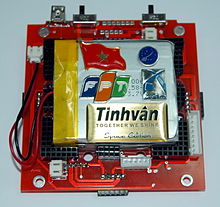
F-1 (satellite)

 Flight Model of F-1 satellite | |
| Mission type | Technology demonstration |
|---|---|
| Operator | FPT University/Uppsala University |
| COSPAR ID | 2012-038E (1998-067CR)[1] |
| SATCAT no. | 38855 |
| Mission duration | Failed to contact ground 100 days (planned) |
| Spacecraft properties | |
| Spacecraft type | CubeSat |
| Manufacturer | FPT University |
| Launch mass | 1 kg (2.2 lb) |
| Dimensions | 10 cm x 10 cm x 10 cm (1U) |
| Start of mission | |
| Launch date | 21 July 2012, 02:06:18 UTC[2] |
| Rocket | H-IIB F3 |
| Launch site | Tanegashima, Yoshinobu LC-Y2 |
| Contractor | Mitsubishi Heavy Industries |
| Deployed from | ISS Kibō Delivered by Kounotori 3 |
| Deployment date | 4 October 2012, 15:44:15.297 UTC |
| Entered service | Failed to contact ground |
| End of mission | |
| Decay date | 9 May 2013[3] |
| Orbital parameters | |
| Reference system | Geocentric orbit |
| Regime | Low Earth orbit |
| Inclination | 51.65° |
 F-1 mission patch | |
F-1 is a CubeSat built by FSpace laboratory at FPT University, in Hanoi, Vietnam, in partnership with Angstrom Space Technology Center (ASTC), Uppsala University, Sweden and Nanoracks LLC, United States. Its mission is to train young engineers and students about aerospace engineering and evaluate an advanced three-axis magnetometer, Spin-Dependent Tunneling Magnetometer (SDTM) designed in Sweden by ASTC.[4]

F-1 was launched on 21 July 2012 and delivered to the International Space Station (ISS) aboard Kounotori 3 (HTV-3) along with the RAIKO, WE WISH, Niwaka and TechEdSat-1 cubesats. Then, on 4 October 2012, it was deployed into orbit from the ISS using the JEM-Small Satellite Orbital Deployer (J-SSOD) which was attached to the Kibō module's robotic arm.[5][6]

As of 2 November 2012, F-1 failed to confirm communication after the orbital deployment.[7]


Hardware
- Structure: aluminium alloy T-6061
- Power supply: body-mounted solar cells, rechargeable Li-Polymer battery
- PIC16 and PIC18 micro-controllers
- Yaesu VX-3R handheld transceivers
- C328 low-resolution camera
- Temperature sensors
- Three-axis magnetometer (ASTC)
- 2-meter band Dipole Antenna
- 70-cm band Dipole Antenna
Specifications

- Size: 10 cm x 10 cm x 10 cm (1U CubeSat)
- Mass: 1 kg
- Communication: 2 independent radios using amateur radio Very high frequency (VHF) and Ultra high frequency (UHF) bands, transmission speed 1200 bit/s; AFSK and PWM Morse code modulation, KISS protocol
- Payload: low resolution C328 camera (640 × 480 maximum resolution, 8 bit color)
- Sensors: temperature sensors and three-axis magnetometer
- Targeted orbit lifetime: at least 3 months on orbit (depend on release altitude from the ISS)
Communication subsystem and Packet format

1. Backup UHF channel (only operational in daylight):

- Frequency: 437.485 MHz
- Modulation: Narrow FM
- Power: about 0.2 watt RF output
- Antenna: half-wave dipole
- Beacon interval: 20 seconds duration, repeated every 90 seconds
Pulse-Width-Modulation Morse code telemetry beacon

| No1 | Data | Description | Size (bits) | Size (chars) |
|---|---|---|---|---|
| 1 | F-1's callsign | "XV1VN" | 5 | |
| 2 | OBC1 reset count | Number of OBC1's reset since the beginning | 8 | |
| 3 | Temperature 1 | °C (temperature inside F-1, OBC board) | 8 | 5 |
| 4 | Temperature 2 | °C (temperature outside F-1, Y- side) | 8 | |
| 5 | Checksum bit | 0 if summary of items #2 to #4 is even, 1 if it is odd | 1 | |
| Total | 10 |
2. Main VHF channel (operational during night time but may be turned on in daylight later)

- Frequency: 145.980 MHz
- Modulation scheme: AFSK/FM
- Power: 1.0 watt RF output
- Antenna: half-wave dipole
- Baud rate: 1200 bit/s
- Telemetry and interval: one burst of 3 telemetry packets in KISS format every 30 seconds (interval configurable)
F-1's KISS packet format

| No | Data | Description | Size (bit) |
|---|---|---|---|
| 1 | Date time | Date: dd/mm/y: 5/4/3=12 bits Time: hh/mm/ss: 5/6/6=17 bits |
29 |
| 2 | Battery voltage | Battery voltage multiplied by 100 (divide by 100 to get actual value) | 11 |
| 3 | Solar cells voltage | Solar cells voltage multiplied by 10 (divide by 10 to get actual value) | 8 |
| 4 | Temperature 1 | °C (side 1, Y+) | 8 |
| 5 | Temperature 2 | °C (side 2, Y-) | 8 |
| 6 | Temperature 3 | °C (side 3, X-) | 8 |
| 7 | Temperature 4 | °C (side 4, Z+) | 8 |
| 8 | Temperature 5 | °C (side 5, Z-) | 8 |
| 9 | Temperature 6 | °C (side 6, X+) | 8 |
| 10 | Temperature 7 | °C (inside side 5, Z-) | 8 |
| 11 | Temperature 8 | °C (inside, under VX-3R1) | 8 |
| Total | 112 bits = 14 bytes |
Note:

- F-1 periodically sends a burst of 3 telemetry packets with the same content, to avoid packet loss
- Time in UTC, 24 hours format
- Year count starting from 2012 (2012 equals 0, 2013 equals 1 and so on...)
- Battery voltage reading is accurate to 0.01 volt, values are multiplied by 100. Divide by 100 to get actual value.
- Solar cells voltage reading is accurate to 0.10 volt, values are multiplied by 10. Divide by 10 to get actual value.
- Temperature readings from sensors, will be added with 100 before transmission to ensure a positive number so please subtract 100 to get actual value
- 112 bits, divided into 14 bytes
References
- ^ "Display: F-1 2012-038E". NASA. 14 May 2020. Retrieved 13 January 2021.
 This article incorporates text from this source, which is in the public domain.
This article incorporates text from this source, which is in the public domain.
- ^ Bergin, Chris (20 July 2012). "Japanese H-IIB launches HTV-3 to the International Space Station". NASASpaceFlight.com. Retrieved 13 January 2021.
- ^ "Trajectory: F-1 2012-038E". NASA. 14 May 2020. Retrieved 13 January 2021.
 This article incorporates text from this source, which is in the public domain.
This article incorporates text from this source, which is in the public domain.
- ^ Gunter, Dirk Krebs (28 January 2020). "F-1". Gunter's Space Page. Retrieved 13 January 2021.
- ^ 大塚実 (25 January 2012). "JAXA、宇宙ステーションから超小型衛星を放出できる装置をプレス公開" (in Japanese). mynavi.jp. Retrieved 13 January 2021.
- ^ 「きぼう」日本実験棟からの小型衛星放出ミッション (in Japanese). JAXA. 5 October 2012. Archived from the original on 13 November 2012. Retrieved 13 January 2021.
- ^ "Attempt to recover the F-1 Amateur Radio CubeSat". 3 November 2012. Archived from the original on 24 September 2015. Retrieved 22 December 2012.
External links
See what we do next...
OR
By submitting your email or phone number, you're giving mschf permission to send you email and/or recurring marketing texts. Data rates may apply. Text stop to cancel, help for help.
Success: You're subscribed now !
